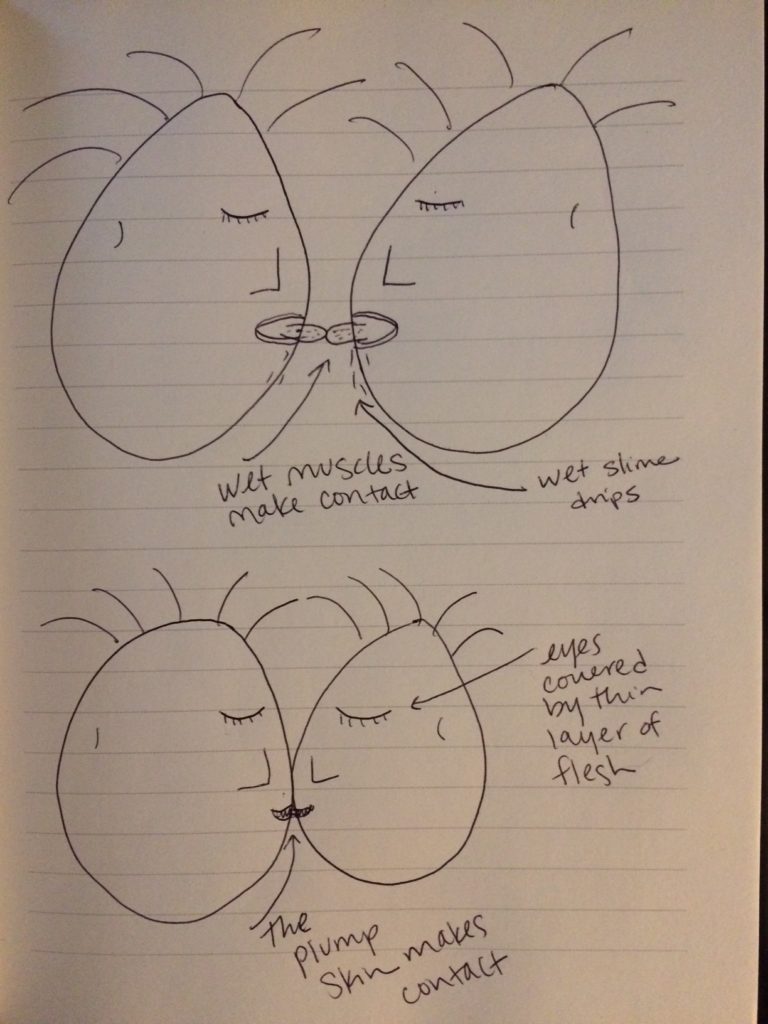NOTE: In an attempt to provide a more comprehensive study of this species, common vernacular will be assumed in all future reports. Please refer to the following linguistic guide:
Upper elongated limb: arm(s)
Bottom elongated limb: leg(s)
Upper smaller limbs: hands/fingers/thumb
Bottom smaller limbs: toes
Small round mound: head
Large cavity: mouth
Middle mound of flesh: midsection
Moist balls: eyes
Side cavities: ears
Short growth with cavities on round mound: nose
ENTRY: Species Greetings
When greeting one another, these species engage in a number of seemingly practiced rituals. The most common forms involve physical contact: mashing midsections together, mashing hands together, mashing the plump skin around their mouths together, or a combination of the aforementioned.
The Midsection Mash:
The midsection mash occurs in a number of different ways and is often accompanied by corresponding sounds from the mouth and movements of the arms. Some individuals will simply bump midsections together a number of times while letting out high and low pitched ringing sounds from their mouth. Others will mash their midsections together while swinging and squeezing their arms around the other person to increase the pressure of the mash. Some midsection mashes last only a few brief seconds with very little arm squeezing, while other mashes last much longer and entail tight arm squeezing.

The Hand Mash:
There are numerous variations of the hand mash. Some individuals will reach out their hands, press their palms together and then wrap the fingers around the palm of another while squeezing. This palm squeeze is not complete until both individuals concurrently swing their intertwined hands up and down approximately the length of 6 inches, at least twice. Another common form of the hand mash is simply swinging one hand forward until it meets the palm of another’s hand and produces a sharp ringing noise. Lastly, although not as common, more elaborate forms of hand mashes have been observed. These might include the wiggling of fingers while only touching finger tips, the bumping of knuckles while the fingers have been rolled tightly into the palm, or combinations of shakes, slaps, bumps, and snaps (which is the linguistic term for pressing the third finger and thumb together and then sliding the finger over the thumb so tight it hits the base of the thumb and creates a sharp sound.

The Mouth Mash:
The mouth mash is often an accompaniment to the midsection mash. The mouth mash involves two individuals moving the front of their heads very close together until the plump skin around their mouths makes contact. This plump skin is then pressed together and pulled apart with slight suction to produce a light popping sound. Some individuals will engage in one mouth mashing, while others will press and pull a number of times to create a succession of suction-popping sounds. Lastly, some individuals will also protrude a wet muscle (linguistic term is “tongue”) from the interior of their mouth and stick it into the mouth of the person they are mashing with. This wet muscle is sloshed around the inside of the other person’s mouth while the mouth mash continues. A wet slime (linguistic term is “saliva) is carried from the inside of one mouth to the other via the tongue and at times dribbles down the sides of mouths while the wet muscle sloshing continues. During the mouth mash normally a thin layer of flesh covers the eyes.

Note: In accordance with code OBEWH2016 the final report will be submitted on January 1, 2018 to the higher council of extra-planetary research. Objective observations are sent every 7 full rotations of the planet in respect to its star and followed by a short summary of findings as directed in the standardized outline for observational reports presented in Handbook 32.7767.96.7970.
